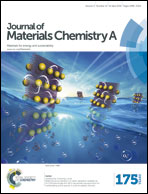A complementary absorption small molecule for efficient ternary organic solar cells†
Abstract
Ternary solar cells are emerging as an attractive strategy to enhance the power conversion efficiencies (PCEs) of binary ones while maintaining the simple processing of single junction devices rather than that of the more complex tandem cells. However, only a few successful ternary blend solar cells have been reported with improved device performance. In this study, a low band gap small molecule DPPEZnP-O, which shows complementary absorption to PTB7, is introduced into PTB7 : PC71BM (PTB7: poly-thieno[3,4-b]thiophene/benzodithiophene; PC71BM: (6,6)-phenyl-C71-butyric acid methyl ester) to fabricate ternary solar cells. A PCE of 8.39% is achieved for the bulk heterojunction (BHJ) ternary solar cells with 20% DPPEZnP-O, which is a 12% enhancement in PCE compared with the binary OSCs based on PTB7 : PC71BM. DPPEZnP-O in PTB7 : PC71BM not only broadens light absorption to the near infrared region from 750 to 900 nm to harvest more photons but also plays a bridging role between PTB7 and PC71BM to provide more charge transfer routes at D/A interfaces. Unlike in many cases, 20% DPPEZnP-O in PTB7 : PC71BM does not form recombination centers to suppress the charge transport process, which also plays a role in the enhanced OSC performance.


 Please wait while we load your content...
Please wait while we load your content...